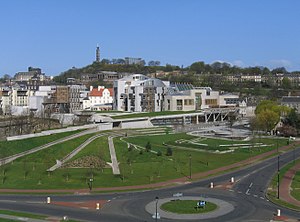
| Part of a series on the |
| Culture of Scotland |
|---|
 |
| People |
| Mythology and folklore |
| Cuisine |
| Religion |
| Art |
| Literature |
The architecture of Scotland includes all human building within the modern borders of Scotland, from the Neolithic era to the present day. The earliest surviving houses go back around 9500 years, and the first villages 6000 years: Skara Brae on the Mainland of Orkney being the earliest preserved example in Europe. Crannogs, roundhouses, each built on an artificial island, date from the Bronze Age and stone buildings called Atlantic roundhouses and larger earthwork hill forts from the Iron Age. The arrival of the Romans from about 71 AD led to the creation of forts like that at Trimontium, and a continuous fortification between the Firth of Forth and the Firth of Clyde known as the Antonine Wall, built in the second century AD. Beyond Roman influence, there is evidence of wheelhouses and underground souterrains. After the departure of the Romans there were a series of nucleated hill forts, often utilising major geographical features, as at Dunadd and Dunbarton.
Castles arrived in Scotland with the introduction of feudalism in the twelfth century. Initially these were wooden motte-and-bailey constructions, but many were replaced by stone castles with a high curtain wall. In the late Middle Ages new castles were built, some on a grander scale, and others, particularly in the borders, simpler tower houses. Gunpowder weaponry led to the use of gun ports, platforms to mount guns and walls adapted to resist bombardment. Medieval parish church architecture was typically simpler than in England, but there were grander ecclesiastical buildings in the Gothic style. From the early fifteenth century the introduction of Renaissance styles included the selective use of Romanesque forms in church architecture, as in the nave of Dunkeld Cathedral, followed more directly influenced Renaissance palace building from the late fifteenth century, beginning at Linlithgow. The private houses of aristocrats adopted some of these features and incorporated features of Medieval castles and tower houses into plans based on the French Château to produce the Scots Baronial style. From about 1560, the Reformation led to the widespread destruction of church furnishings, ornaments and decoration and in post-Reformation period a unique form of church emerged based on the T-shaped plan.
After the Restoration in 1660, there was a fashion for grand private houses influenced by the Palladian style and associated with the architects Sir William Bruce and James Smith. Scotland produced some of the most significant British architects of the eighteenth century, including: Colen Campbell, James Gibbs, William Chambers and particularly Robert Adam. They looked to classical models and Edinburgh's New Town was the focus of a classical building boom. The Industrial Revolution transformed Scottish towns, leading to urban sprawl, exemplified by tenements like those of the Gorbals in Glasgow. New towns, of designed communities like New Lanark, developed from 1800 by Robert Owen, were one solution. Sociologist Patrick Geddes (1854–1932) preferred "conservative surgery": retaining the best buildings in an area and removing the worst. There was a revival of the baronial style, particularly after the rebuilding of Abbotsford House for Walter Scott from 1816, and a parallel revival of the Gothic in church architecture. Neoclassicism was pursued by William Henry Playfair, Alexander "Greek" Thomson and David Rhind. The late nineteenth century saw some major engineering projects including the Forth Bridge, a cantilever bridge and one of the first major all steel constructions in the world.
The most significant Scottish architect of the early twentieth century, Charles Rennie Mackintosh, developed a unique and internationally influential "Glasgow style". Architects who continued to employ styles informed by the past included James Robert Rhind and James Miller. From the mid-twentieth century, architecture in Scotland became increasingly utilitarian and influenced by modernism. Key Scottish architects in this movement included Thomas S. Tait, James Stirling and James Gowan. The introduction of brutalism led to urban clearances and extensive use of the tower block. The style was also used in new towns like Glenrothes and Cumbernauld, but has received considerable criticism. More recent major architectural projects include the Scottish Exhibition and Conference Centre, Glasgow, the many striking modern buildings along the side of the River Clyde and the Scottish Parliament Building in Edinburgh.